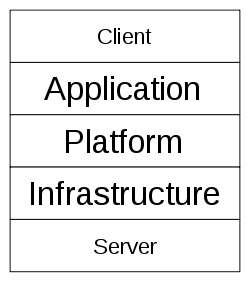Cloud computing From Wikipedia
Cloud computing is a way of computing, via the Internet, that broadly shares computer resources instead of using software or storage on a local PC.
Cloud computing is a byproduct and consequence of the ease-of-access to remote computing sites provided by the Internet.
It is a paradigm shift from current use of PCs, whereby details are abstracted from the users who no longer have need of, expertise in, or control over the technology infrastructure "in the cloud" that supports them. Cloud computing describes a new supplement, consumption and delivery model for IT services based on the Internet, and it typically involves the provision of dynamically scalable and often virtualized resources as a service over the Internet.
The term cloud is used as a metaphor for the Internet, based on the cloud drawing used in the past to represent the telephone network, and later to depict the Internet in computer network diagrams as an abstraction of the underlying infrastructure it represents. Typical cloud computing providers deliver common business applications online which are accessed from a web browser, while the software and data are stored on servers.
A technical definition is "a computing capability that provides an abstraction between the computing resource and its underlying technical architecture (e.g., servers, storage, networks), enabling convenient, on-demand network access to a shared pool of configurable computing resources that can be rapidly provisioned and released with minimal management effort or service provider interaction." This definition states that clouds have five essential characteristics: on-demand self-service, broad network access, resource pooling, rapid elasticity, and measured service. Narrowly speaking, cloud computing is client-server computing that abstract the details of the server away – one requests a service (resource), not a specific server (machine). However, cloud computing may be conflated with other terms, including client-server and utility computing, and the term has been criticized as vague and referring to "everything that we already do".
The majority of cloud computing infrastructure, as of 2009[update], consists of reliable services delivered through data centers and built on servers. Clouds often appear as single points of access for all consumers' computing needs. Commercial offerings are generally expected to meet quality of service (QoS) requirements of customers and typically offer SLAs.
Comparisons
Cloud computing should not be confused with:
- Grid computing — "a form of distributed computing and parallel computing, whereby a 'super and virtual computer' is composed of a cluster of networked, loosely coupled computers acting in concert to perform very large tasks"
- Utility computing — the "packaging of computing resources, such as computation and storage, as a metered service similar to a traditional public utility, such as electricity";
- Autonomic computing — "computer systems capable of self-management".
- Client-server – Client-server computing refers broadly to any distributed application that distinguishes between service providers (servers) and service requesters (clients). Cloud computing is a narrower form of client-server, where the details of the server are abstracted – for example, one may not connect to a specific server. However, due to the popularity of the cloud metaphor, "cloud computing" may be used to refer to any form of client-server computing.
Architecture
History
The underlying concept of cloud computing dates back to 1960, when John McCarthy opined that "computation may someday be organized as a public utility"; indeed it shares characteristics with service bureaus that date back to the 1960s. The actual term "cloud" borrows from telephony in that telecommunications companies, who until the 1990's primarily offered dedicated point-to-point data circuits, began offering Virtual Private Network (VPN) services with comparable quality of service but at a much lower cost. By switching traffic to balance utilization as they saw fit they were able to utilise their overall network bandwidth more effectively. The cloud symbol was used to denote the demarcation point between that which was the responsibility of the provider from that of the user. Cloud computing extends this boundary to cover servers as well as the network infrastructure.
Amazon played a key role in the development of cloud computing by modernizing their data centers after the dot-com bubble, which, like most computer networks, were using as little as 10% of their capacity at any one time just to leave room for occasional spikes. Having found that the new cloud architecture resulted in significant internal efficiency improvements whereby small, fast-moving "two-pizza teams" could add new features faster and easier, Amazon started providing access to their systems through Amazon Web Services on a utility computing basis in 2005. This characterization of the genesis of Amazon Web Services has been characterized as an extreme over-simplification by a technical contributor to the Amazon Web Services project.
In 2007, Google, IBM, and a number of universities embarked on a large scale cloud computing research project. By mid-2008, Gartner saw an opportunity for cloud computing "to shape the relationship among consumers of IT services, those who use IT services and those who sell them", and observed that "organisations are switching from company-owned hardware and software assets to per-use service-based models" so that the "projected shift to cloud computing ... will result in dramatic growth in IT products in some areas and in significant reductions in other areas."
Layers
Deployment models
Public cloud
Public cloud or external cloud describes cloud computing in the traditional mainstream sense, whereby resources are dynamically provisioned on a fine-grained, self-service basis over the Internet, via web applications/web services, from an off-site third-party provider who shares resources and bills on a fine-grained utility computing basis.
Community cloud
A community cloud may be established where several organizations have similar requirements and seek to share infrastructure so as to realize some of the benefits of cloud computing. With the costs spread over fewer users than a public cloud (but more than a single tenant) this option is more expensive but may offer a higher level of privacy, security and/or policy compliance. Examples of community cloud include Google's "Gov Cloud".
Hybrid cloud
A hybrid cloud environment consisting of multiple internal and/or external providers "will be typical for most enterprises". By integrating multiple cloud services users may be able to ease the transition to public cloud services while avoiding issues such as PCI compliance.
Private cloud
Private cloud and internal cloud are neologisms that some vendors have recently used to describe offerings that emulate cloud computing on private networks. These (typically virtualisation automation) products claim to "deliver some benefits of cloud computing without the pitfalls", capitalising on data security, corporate governance, and reliability concerns. They have been criticized on the basis that users "still have to buy, build, and manage them" and as such do not benefit from lower up-front capital costs and less hands-on management, essentially "[lacking] the economic model that makes cloud computing such an intriguing concept".
The term has also been used in the logical rather than physical sense, for example in reference to platform as a service offerings, though such offerings including Microsoft's Azure Services Platform are not available for on-premises deployment.




댓글 없음:
댓글 쓰기